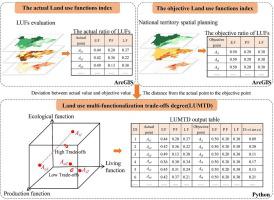当前位置:
X-MOL 学术
›
Ecol. Indic.
›
论文详情
Our official English website, www.x-mol.net, welcomes your feedback! (Note: you will need to create a separate account there.)
Improved trade-off model of land use functions: Differentiated objective setting by territory spatial planning
Ecological Indicators ( IF 6.9 ) Pub Date : 2024-03-16 , DOI: 10.1016/j.ecolind.2024.111881 Zhanyun Wang , Wei Deng , Shaoyao Zhang , Hao Zhang
Ecological Indicators ( IF 6.9 ) Pub Date : 2024-03-16 , DOI: 10.1016/j.ecolind.2024.111881 Zhanyun Wang , Wei Deng , Shaoyao Zhang , Hao Zhang

|
Land use functions (LUFs) refer to the capacity of a land use system to supply human welfare; understanding the trade-offs among multiple LUFs to transform land systems for people and nature is pivotal. The traditional way to assess the degree of trade-off between functions based on the level of multiple functions ignores the differences in natural and social conditions for developing ecological, productive, and livelihood functions of land in different regions. That method makes it difficult to achieve effective land use optimization strategies. In this study, an improved framework for identified trade-offs of production-living-ecological function indicator was developed. Based on the national territory spatial planning, we constructed land use multifunctionality trade-offs degree (LUMTD) and analysed the relationship between the indicators. A generalized additive model was also used to explore the natural and human impacts on land use multifunctionality trade-offs. Land use conflicts were found to be more intense in high altitudes and in transition zones between high altitudes. The LUMTD in the plains dominated by classes I and II accounted for 50 % of the total; it was dominated by classes IV and V in the plateau and its transition areas and accounted for more than 50 % of the total. Our results suggest that the influence of natural and socioeconomic factors on LUMTD had a clear threshold, with the threshold effect of altitude on LUMTD beginning to occur within the 1,000 ∼ 2,000 m elevation range, of temperature at 10 °C, and of built-up land density at 1,200. An efficient differentiation strategy for avoiding land use conflict might be collaborative land management actions that focus on the coordinated development of land production, ecological, and living functions.
中文翻译:

改进土地利用功能权衡模型:地域空间规划差异化目标设定
土地利用功能(LUF)是指土地利用系统提供人类福利的能力;了解多种 LUF 之间的权衡对于改变人类和自然的土地系统至关重要。传统的基于多功能水平评估功能权衡程度的方法忽视了不同地区土地发挥生态、生产、民生功能的自然和社会条件的差异。这种方法很难实现有效的土地利用优化策略。在本研究中,开发了一个改进的框架来确定生产-生活-生态功能指标的权衡。基于国土空间规划,构建土地利用多功能权衡度(LUMTD)并分析指标之间的关系。还使用广义相加模型来探索自然和人类对土地利用多功能权衡的影响。研究发现,高海拔地区和高海拔过渡区的土地利用冲突更为激烈。平原地区以Ⅰ、Ⅱ类为主的LUMTD占总量的50%;高原及其过渡地区以IV、V类为主,占总量的50%以上。我们的研究结果表明,自然和社会经济因素对LUMTD的影响有一个明确的阈值,海拔对LUMTD的阈值效应在1,000 ∼ 2,000 m海拔范围内开始出现,温度在10 °C,建筑的阈值效应开始出现。土地密度为 1,200。避免土地利用冲突的有效差异化策略可能是注重土地生产、生态和生活功能协调发展的协同土地管理行动。
更新日期:2024-03-16
中文翻译:

改进土地利用功能权衡模型:地域空间规划差异化目标设定
土地利用功能(LUF)是指土地利用系统提供人类福利的能力;了解多种 LUF 之间的权衡对于改变人类和自然的土地系统至关重要。传统的基于多功能水平评估功能权衡程度的方法忽视了不同地区土地发挥生态、生产、民生功能的自然和社会条件的差异。这种方法很难实现有效的土地利用优化策略。在本研究中,开发了一个改进的框架来确定生产-生活-生态功能指标的权衡。基于国土空间规划,构建土地利用多功能权衡度(LUMTD)并分析指标之间的关系。还使用广义相加模型来探索自然和人类对土地利用多功能权衡的影响。研究发现,高海拔地区和高海拔过渡区的土地利用冲突更为激烈。平原地区以Ⅰ、Ⅱ类为主的LUMTD占总量的50%;高原及其过渡地区以IV、V类为主,占总量的50%以上。我们的研究结果表明,自然和社会经济因素对LUMTD的影响有一个明确的阈值,海拔对LUMTD的阈值效应在1,000 ∼ 2,000 m海拔范围内开始出现,温度在10 °C,建筑的阈值效应开始出现。土地密度为 1,200。避免土地利用冲突的有效差异化策略可能是注重土地生产、生态和生活功能协调发展的协同土地管理行动。



























 京公网安备 11010802027423号
京公网安备 11010802027423号